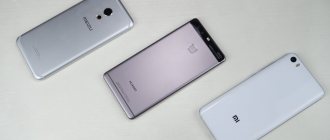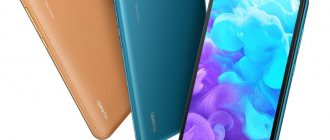Specifications
Before we get into the Xiaomi Mi6 vs Huawei Honor 9 clash in detail, let's first take a close look at their specifications. This will at least help us better understand the equipment of both devices and their basic capabilities.
Xiaomi Mi6:
- Single-chip system: Processor – eight-core Qualcomm Snapdragon 835 (4 Kryo cores 2.45 GHz, 4 Cortex A-53 cores 1.9 GHz) Graphics accelerator – Adreno 540 710 MHz;
- Display: 5.15 inches, IPS matrix, Full HD (1920x1080), pixel density 428 PPI;
- Operating system: Android 7.1.1 plus proprietary MIUI 8.0 shell;
- Memory: RAM – 6 gigabytes. Main – 64 or 128 gigabytes;
- Supported frequencies : GSM 850/900/1800/1900 MHz, UMTS 800/850/900/1700/1900/2100 MHz, LTE 1, 3, 5, 7, 8;
- Wireless interfaces: Bluetooth 5.0, Wi-Fi (802.11ac, 2×2 MIMO, MU-MIMO), NFC;
- Cameras: Main – 12 megapixels, f/1.8 aperture, 27 mm focal length, 4-axis optical stabilization, plus a 12 megapixel camera with a 52 mm telephoto lens, f/2.6 aperture. Front – 8 megapixels, f/2.0 aperture;
- Navigation: GPS, GLONASS, Beidou;
- Set of sensors: Light sensor, proximity sensor, accelerometer, gyroscope, digital compass, fingerprint scanner;
- Battery: 3350 milliamp hours;
- Dimensions: Dimensions – 145.17x70.49x7.45 mm. Weight - 168 grams.
Honor 9:
- Single-chip system: Processor – eight-core HiSilicon Kirin 960 (4 Cortex A-73 2.4 GHz cores, 4 Cortex A-53 1.8 GHz cores) Graphics accelerator – Mali-G71MP8 1037 MHz;
- Display: 5.15 inches, IPS matrix, Full HD (1920x1080), pixel density 428 PPI;
- Operating system: Android 7.0 plus proprietary shell Emotion UI 5.1;
- Memory: RAM – 4 or 6 gigabytes. Main – 64 or 128 gigabytes, micro-SD support up to 256 gigabytes;
- Supported frequencies : 2G (850/900/1800/1900); 3G (850/900/1700/1900/2100); 4G (b1/b3/b5/b7/b8/b20/b38/b40/b41);
- Wireless interfaces: Bluetooth 4.2, Wi-Fi 802.11a/b/g/n/ac 2.4 and 5 GHz, NFC;
- Cameras: Main 0 12 megapixel RGB, f/2.2 aperture, plus 20 megapixel monochrome camera, f/2.2 aperture. Front – 8 megapixels, f/2.0 aperture;
- Navigation: GPS, GLONASS, Beidou;
- Set of sensors: Proximity sensor, lighting sensor, magnetic field sensor, accelerometer, gyroscope, step counter, fingerprint scanner;
- Battery: 3200 milliamp hours;
- Dimensions: Dimensions – 147.3x70.9x7.45 mm. Weight – 155 grams.
As you can see, the parameters of smartphones are really very similar. For the most part, they differ only in single-chip systems and the camera, but otherwise the differences are not so significant. Well, let's see how the phones behave in a direct comparison.
Equipment
Comparing Mi6 and Honor 9 in terms of equipment turned out to be not as simple as we initially thought. And the main problem here is that there is nothing special to compare. Both smartphones are supplied in rather unassuming white boxes made of thick cardboard. The box for Xiaomi looks quite standard, while the Honor 9 and its components are located inside in a rather unusual vertical way, like books on a shelf. Apart from this interesting detail, the rest of the equipment is almost identical. So, in both boxes we were able to find:
Xiaomi Mi6
- USB Type-C cable for charging and synchronization.
- Included 2 amp charger.
- Silicone bumper on the back cover.
- A paperclip for removing the SIM card tray.
- Accompanying documentation.
The only slight difference is that the Mi6 also has a special adapter from USB Type-C to a standard 3.5 mm headphone jack in the box, because the phone itself is not equipped with such a jack. Honor 9 has such a connector on the body of the smartphone itself, so naturally such an accessory is not included in its package.
Honor 9
Design
In design, these devices are also very similar to each other. Both smartphones have a metal body covered with tempered glass; both have a slightly convex back cover with sloping edges and rounded corners. From the back of the phones, very similar eyes of dual cameras look at us, which are equipped with a flash and neatly placed under protective glass, and on the front side there is a fingerprint scanner.
Huawei Honor 9
One could say that the design of smartphones is almost like twins, but this is only at first glance. If you search, you can actually find many very significant differences between them. Firstly, the smartphone from Huawei turned out to be slightly larger than its competitor and has dimensions of 147.3 × 70.9 × 7.5 mm versus 145.17 × 70.49 × 7.45 mm. That is, it is simultaneously wider, longer, and thicker than Xiaomi. The difference, of course, is small, but there may be people for whom this parameter will be very critical. However, despite its size, Honor for some reason turns out to be lighter than its rival: 155 grams versus 168, which seems rather strange. Secondly, Xiaomi has an almost glossy back side, while Honor’s back cover consists of many layers processed using photoengraving technology, which is why it acquires a very beautiful shimmer effect and plays gorgeously with colors in the sun.
Xiaomi Mi6
Another important difference between the devices is that Honor 9 has a 3.5 mm headphone jack, which is located on the bottom edge of the device next to Type-C and the main speaker grille. Xiaomi does not have such a connector; apparently, they decided to abandon it in favor of higher protection against splashes and dust: speaker grilles are simply placed next to the port, one of which plays a decorative function. The rest of the phones are standard, the same familiar front cameras, volume rockers, lock button, SIM card tray. As they say, everything is in its place; here the companies did not experiment and left the functional elements in the most convenient position for the user.
Phones are supplied to the Russian market in various color options. Xiaomi has the usual white, black, and blue colors. Meanwhile, Huawei has decided to highlight the beautiful iridescent effect of its new line, and therefore the color palette of the Honor 9 phones includes: midnight, sapphire and ice gray. All the colors are quite stylish and pleasing to the eye, so it makes no sense to recommend any one of them, everyone will choose based on their preferences, and they definitely won’t go wrong.
It’s quite difficult to say which is better in terms of design – Xiaomi Mi6 or Honor 9. The phones are very similar, Xiaomi turned out to be more compact, but at the same time Honor looks very impressive and even fascinates in the first minutes of communication with it. In this matter, everyone must decide for themselves what is more important at the moment, but we will give our point to Honor 9.
Design is a new trend of Chinese manufacturers
In the design of both smartphones, general trends can be seen quite clearly. Now many Chinese manufacturers have developed a love for glass phone cases and dual camera modules. This is not to say that this is something bad, at least this trend has not yet become boring and is gradually being replaced by another trend for full-screen devices.
In this case, we have phones with a metal body, which is completely covered with tempered glass on both sides, and the only thing that reminds us of metal is the glossy insert around the perimeter of the entire body, where the main functional elements are located. Smartphones have sloping edges for a more comfortable hold in the palm, as well as neatly beveled corners. Both devices are quite compact and have dimensions of 147.3 x 70.9 x 7.45 mm for Honor and 145.17 x 70.49 x 7.45 mm for Xiaomi. As you can see, Xiaomi is somewhat smaller than its competitor, which can be regarded as an advantage by some buyers. At the same time, the Mi6 is a little heavier - 168 grams versus 155 for its opponent.
The phones are sold in several colors. For Xiaomi, this is traditional black, the always popular white, and also the new blue-gold color. Huawei decided to name its shades more original, resulting in: midnight, sapphire and icy gray. Both smartphones look great, but Xiaomi has a simpler glossy back cover that can change color slightly in the sun.
Honor's back cover is multi-layered and made using photo-engraving technology, thanks to which the smartphone has a very beautiful shimmer effect that makes the phone look very unusual. If we compare the Mi6 and Honor 9 regarding the practicality of their cases, then Honor will also win. In addition to beauty, the back cover of the “nine” also seems to be stronger than that of its rival, it is less susceptible to scratches, chips, and also does not slide as much on flat surfaces, unlike the Mi6.
Our today's heroes also resemble each other in terms of the placement of functional elements. However, there is still a slight difference, since Xiaomi Mi6 is not equipped with a 3.5 mm jack, while Honor has this port located on the bottom end near USB-C and the main speaker. Xiaomi has in this place, in addition to the above-mentioned main port and speaker, only a second decorative grille, under which the speaking microphone is hidden.
Otherwise, the smartphones are almost identical, so in both cases we see a dual camera with LED flash on the back cover, a fingerprint scanner at the bottom on the front panel, and a speaker, front camera and sensors at the top. At the top end there is an active noise reduction microphone and an infrared port, and on the sides there are standard volume control buttons and a lock key on one side, and a SIM card tray on the other.
It is not easy to give preference to Huawei Honor 9 or Xiaomi Mi6 in terms of the quality of their design. The point is not that they are both good, but that the issue of design is mostly a matter of the individual taste of each buyer. Subjectively, in our opinion, Honor looks a little more attractive, but we don’t see much point in evaluating smartphones based on this block.
Design and appearance
In the Xiaomi Mi 6 vs Huawei Honor 9 comparison, it will be difficult to determine which smartphone looks better, since both devices have a stylish appearance. Honor 9 has Corning Gorilla Glass. The model is presented only in dark colors: black, gray and blue.
The Honor 9 case is equipped with a metal frame, which has become an integral part of it. The dimensions of the device are 147.3 × 70.9 × 7.45 mm, and the weight is 155 g. This is a comfortable smartphone that fits nicely in the hand. Above the screen there is a selfie camera, sensors, an event indicator and a speaker. At the bottom, in addition to the standard Back and Menu touch buttons, you can see the Home key with a built-in fingerprint scanner. On the back of Honor 9 there are 2 cameras, an LED flash and a focusing system.
The Xiaomi Mi6 smartphone has a glass-metal body. It's a mid-sized device that's larger than the iPhone 7 but smaller than phones with 5.5" screens. Weight is 168 g. The case can be made in black, blue or white.
The design shares similarities with the Samsung Galaxy S8. Due to the glass coating, cracks may appear on the smartphone after being dropped. Unlike Honor 9, the device is not equipped with a 3.5 mm jack for connecting headphones. The front panel of the phone contains an indicator of missed events and a fingerprint scanner.
Display
Xiaomi Mi6 and Honor 9 have almost identical displays. In both cases, these are IPS screens measuring 5.15 inches, with a resolution of 1920x1080 pixels and a pixel density of 428 ppi. In addition, in terms of image quality, they are also close to each other. If you look only at the picture, but don’t know which phone is which, it won’t be difficult to confuse them.
If you look as closely as possible, you will notice that the colors look a little brighter on the Huawei phone, which indicates a wider color gamut than the competitor, which shows a more natural picture. At the same time, Xiaomi has better black color, which is also an important parameter when it comes to an IPS matrix. White is equally good on both smartphones, but on Honor 9 it is more stable, while on Xiaomi it can turn a little pink when deviating from perpendicular. In general, at acute viewing angles, the screens remain highly readable, the contrast and brightness drop slightly, and the image is not inverted.
Honor 9
With maximum brightness, the reviewed models are in perfect order. For Xiaomi, this figure is equal to 511 cd/m2, and for Honor – as much as 520 cd/m2. With such indicators, our heroes are not afraid of even very bright sun; in tandem with a high-quality anti-reflective coating, they always remain clearly readable. The phones will also please those who like to read from the screen in the dark. The minimum brightness for Honor 9 is 3 cd/m2, while Mi6 boasts 1 cd/m2, which is equal to the brightness level of a dim candle.
Both screens are completely covered with protective tempered glass, processed using 2.5D technology, and are also equipped with a high-quality oleophobic coating. During the test, we did not manage to get them very dirty, and even those traces that managed to accumulate were then removed quite easily. The multi-touch test demonstrated that both smartphones perfectly support up to ten simultaneous touches. The sensors of both Xiaomi and Honor work great; there are absolutely no complaints about them in terms of sensitivity and accuracy.
Xiaomi Mi6
To summarize, I would like to say that the displays of the reviewed models are fully worthy of the top segment. They are not ideal, but based on the sum of their parameters, their characteristics can be called very high. In addition, during the tests, the smartphones performed excellently; with numerous use cases, neither backlight flickering nor strong color distortion was noticeable. In this situation, the conclusion follows that smartphones are equal to each other in terms of display quality.
Screens
Xiaomi has a screen diagonal of 5.15 inches. Honor 9 has the same diagonal. This is a very convenient diagonal for operating with one hand. But the compactness of the device is also very important. Huawei 9 is 2 millimeters taller than Mi 6. Otherwise, the phones are almost identical.
Users also like the screen better on the Honor 9. It has a more correct color scheme, a natural white color without a warm tint, like the Mi 6. But here everyone has their own vision, vision and understanding.
The screens of Honor 9 or Xiaomi Mi6 have an oleophobic coating. Five seconds and the device is absolutely clean, just like out of the box. Both displays are also 2.5 d, which adds some elegance and beauty.
Sound
The Xiaomi Mi6 smartphone sounds very good, even considering its status as a top-end device. This is achieved thanks to stereo speakers, as well as the forces of a modern single-chip system. The sound from the speakers is not too loud, but it is clear and spacious, and the entire sound range from high to low frequencies is fully transmitted. With headphones, things are even better, the sound becomes richer, brighter, and its quality rises to a new level. But you may have problems connecting the headset. Xiaomi decided to abandon the standard 3.5 millimeter jack in favor of better water protection and, in our opinion, it was a hasty decision. Now music lovers will either have to constantly use the included adapter, or buy expensive wireless headphones. With this approach, even despite the good sound, it is very difficult to recommend this smartphone to music lovers.
At the same time, Honor 9 not only does not lack a standard mini-jack port for regular headphones, it also has a special dedicated Hi-Fi chip, which significantly improves the sound. If, when playing music through external speakers, the phones still argue among themselves in terms of quality, then in headphones the Honor sound seems much more advanced. It’s difficult to put into words, it would seem that in both cases the sound is called good and this is indeed the case, but when directly comparing the phones with each other, Honor still takes the upper hand. In addition, the Huawei smartphone boasts a very good equalizer called Honor Purity, which makes listening to music even more enjoyable. Taking into account all of the above, for music lovers the best choice in this case would be Honor 9.
Cameras
The cameras of Xiaomi MI6 and Honor 9 are very similar to each other. In both cases we have a dual camera with two different sensors. However, these modules differ in functionality and perform different functions in both cases. So, in the case of Xiaomi, the first camera is a 12-megapixel wide-angle lens with f/1.8 aperture, which carries out the bulk of the tasks, and the second camera is essentially a 12-megapixel telephoto lens with a significantly larger focal length and f/2.6 aperture. designed for so-called optical zoom without loss of quality.
In the case of Honor 9, the cameras work differently. So, the main camera is an RGB module with a resolution of 12 megapixels and f/2.2 aperture. And the second camera is a monochrome 20-megapixel module, also with f/2.2 aperture. Both cameras work simultaneously, after which the image is combined into one shot. Thus, the RGB module is responsible for transmitting color in photographs, and the high-resolution monochrome module ensures that the picture is as clear, detailed and contrasting as possible.
The photo quality of Xiaomi Mi6 can be safely called very good. Colors are reproduced correctly, white balance is excellent, clarity and detail are also normal. However, when it comes to working in shaded areas, this is where the phone has problems. The image seems too dark, and in such cases the only thing that helps is activating the HDR mode, which, although soft, still makes the picture much brighter. I would also like to praise the Xiaomi Mi6 for night photography and optical stabilization. The phone's images at night are simply excellent, there is no noise, the overall detail and elaboration of objects in poor lighting on the smartphone is excellent. Stabilization helps a lot both in night photography and when shooting in motion, plus you get used to it very quickly, which makes it difficult to return to smartphones without such a function.
Xiaomi Mi6
I would also like to say a few words about the 2x optical zoom. It's really very good, it works quickly, it's convenient to use, and the shooting quality is only slightly worse than with the main camera. But the second lens no longer has optical stabilization, so sometimes you forget about it, switching between cameras on the go, which is why sometimes the pictures turn out blurry.
Honor 9 is also doing very well. Colors are just as good as the competitor's, but in terms of clarity, detail and contrast, the stronger monochrome camera makes its presence felt. Based on the sum of these parameters, we liked the photos of Honor 9 a little more than those of Xiaomi, and in terms of working out dark and light areas, it copes a little better even without turning on additional modes. But in night photography, this smartphone is somewhat inferior to its competitor, and the reason for this, in our opinion, is the complete lack of optical stabilization in the smartphone’s camera. It would seem that such a function should be present in a flagship by default, but it’s not even close here, as a result of which the pictures often turn out a little blurry in low light or when trying to photograph something on the go.
Honor 9
Both smartphones can shoot video in 4K format at 30 frames per second or Full HD at 60 frames per second. The quality of color rendering, detail and clarity are at approximately the same level. Xiaomi again greatly outperforms its competitor due to the presence of optical stabilization, which is even more important for shooting video than for photography. However, Honor, in turn, produces much better sound, with which Xiaomi has obvious problems due to the rather aggressive operation of the active noise reduction microphone.
As for the front cameras, there is not much to say. Both phones have an 8-megapixel camera with f/2.0 aperture. These cameras take pictures quite well, there are no complaints about the quality of selfies, moreover, they take pictures much better than on most mid-budget smartphones. However, this time it was deprived of additional functions, such as flash or autofocus. Nevertheless, both smartphones have good decoration modes, which will not be superfluous for selfie lovers.
Honor 9
To sum up, we can say that we liked the photos of Honor 9 more than those of Xiaomi Mi6, and we would give the victory in this round to it. However, this victory is still incomplete, since optical stabilization, which the Mi6 has, is very important for this class of smartphones and brings them a lot of points. And a high-quality 2x optical zoom without much loss in quality will never be superfluous either.
Differences between Honor 9 and Xiaomi Mi6
Still, the Xiaomi Mi6 processor has a technological process of 10 nm , while the Honor 9 has a 16 nm process, and the frequency of the former is slightly higher. This takes a toll on endurance and performance, which is likely the reason for some of the price difference.
Smartphone cameras have functional differences. Xiaomi Mi6 has two 12 megapixel cameras: the first with a wide viewing angle and f/1.8 . f/2.6 aperture . This gives optical zoom with high real image quality. Honor 9 has a 12-megapixel color camera paired with a 20-megapixel monochrome camera, both with the same f/2.2 . The result is a kind of digital zoom. The choice is up to the amateur, whether or not he understands these concepts.
Ø3.5 mm wired interface on Honor 9 makes it more attractive to users who like to use a wired headset.
Although you can also connect to Xiaomi Mi6, but through an adapter if you are not accustomed to the Bluetooth interface, which works great for both phones.
Memory and memory card
Honor 9 has on board 4 or 6 gigabytes of LPDDR4 RAM with a frequency of 1866 MHz, as well as 64 or 128 gigabytes of fast UFS 2.1 class permanent memory. Xiaomi Mi6 at the beginning of sales could only offer two versions - one with 6 gigabytes of RAM and 64 gigabytes of permanent storage, the second also with 6 gigabytes of RAM, but already 128 gigabytes of permanent storage. However, a few months later, Xiaomi also launched a more budget version of the smartphone with 4 gigabytes of RAM and 64 gigabytes of storage. Like Honor, Xiaomi's RAM is LPDDR4 1866 MHz, and the permanent memory is also labeled UFS 2.1.
In terms of memory speed, smartphones are almost equal. However, Honor 9 has an advantage over its competitor in the form of support for micro-SD memory cards, while Xiaomi refused such support in the Mi6. This is not to say that even Xiaomi’s minimum 64 gigabytes of permanent memory is not enough, but to some extent, support for memory cards gives flexibility and the ability to easily upgrade your smartphone if you still need additional memory in the near future. Honor 9 supports micro-SD cards with a capacity of up to 256 gigabytes, so its owners will certainly not encounter a lack of memory.
Performance
What is better in terms of “stuffing”: Xiaomi Mi 6 or Honor 9? Here, of course, Mi 6 is ahead, since the top-end Snap 835 with 10-nanometer technology is very fast and productive.
Kirin 960 from Huawei in this case is more impressive. The number in Antutu is proof of this. But synthetics do not always reflect reality. In fact, optimization multiplied by “even” hands is important. For example, Oswald launches faster on Huawei than on Mi 6. Although Mi 6 has 6 GB of memory versus 4 for the competing gadget.
But even when unpacking the Honor 9, you can feel its heating. With the latest update this has almost been fixed. The difference in heating is on average 2-3 degrees. At the same time, the programmers did not “stupidly” lower the frequencies.
The browser and other applications are a fraction of a second, but still faster than the Mi 6. Mi6 and Honor 9 support all modern mobile network frequencies, so you definitely won’t have any problems with this.
Battery life and performance
Xiaomi Mi6 is equipped with the most advanced Qualcomm Snapdragon 835 chipset to date. This is a 10nm octa-core processor, made according to the Big/Little core layout and has 4 Kryo 280 cores clocked at 2.45 GHz, as well as 4 Cortex A-53 cores clocked at 1.9 GHz. Honor 9 is equipped with an older, but not much less powerful, chipset of its own production, a 16-nanometer, eight-core HiSilicon Kirin 960. This processor is also made in a Big/Little layout and has 4 Cortex A-73 cores clocked at 2.4 GHz and 4 Cortex cores A-53 with a clock frequency of 1.8 GHz.
Comparing Honor 9 and Xiaomi Mi6 in terms of single-chip systems is both simple and difficult. On the one hand, Snapdragon 835 is much newer, more powerful and more economical; in any case, it beats its competitor in all respects. On the other hand, Snapdragon is a very progressive processor and today it is sufficient for all applications and programs that you can imagine. And although the HiSilicon Kirin 960 is inferior to its rival, if you believe the benchmarks, then it is not by much and, naturally, it is also enough for all everyday tasks. If both “stones” have no difficulties in their work, how can we evaluate who is really cooler? Of course, Snapdragon is more powerful; if you use the smartphone for a long time, then its performance will be sufficient for the future with a large margin, but here and now we can only trust benchmarks.
| Benchmark | Honor 9 (HiSilicon Kirin 960) | Xiaomi Mi6 (Qualcomm Snapdragon 835) | LG G6 (Qualcomm Snapdragon 821) | Meizu Pro 6 Plus (Samsung Exynos 8890 Octa) | Samsung Galaxy S8+ (Samsung Exynos 8895 Octa) |
| AnTuTu (v6.x) | 144888 | 181722 | 138718 | 113351 | 172891 |
| GeekBench (v4.x) | 1838/6437 | 1912/6689 | 1741/4221 | 1482/3836 | 2008/6433 |
As for gaming performance, the Adreno 540 at 710 MHz is approximately twice as powerful as the Mali-G71MP8 at 1037 MHz. It is worth saying that the Snapdragon 835 feels great in games even with Quad HD resolution, and with the Full HD resolution of the Xiaomi Mi6 it has no problems whatsoever. Even the heaviest games run at maximum settings with maximum frame rates. However, surprisingly, with Full HD and Kirin 960 does not experience any problems. That is, if we compare not single-chip systems, but directly monitored smartphones, it turns out that in games they behave approximately the same.
Comparing smartphones in terms of autonomy, we will notice that both smartphones are equipped with similar batteries, although Xiaomi’s capacity is slightly higher – 3350 milliampere hours versus 3200 milliampere hours for its competitor. With the naked eye, you won’t see any particular difference; both devices will last a full working day without any particular difficulties, and if you use the phones moderately, you can count on two days of work without recharging. A more significant difference emerges if you test autonomy with energy-saving functions turned off. So, in the case of Honor 9, you can count on: 12 hours of reading mode, 8 hours of video viewing mode and 4 hours of heavy gaming. At the same time, Xiaomi can work: 14 hours in reading mode, 8 hours 30 minutes when watching videos, 4 hours 30 minutes in games. It is also worth noting that both devices support fast charging technology and gain a full charge from zero to one hundred percent in about two hours.
operating system
Xiaomi Mi6 comes with the Android operating system version 7.1.1 and the proprietary MIUI 8.0 shell. Honor 9, out of the box, runs Android 7.0 and the proprietary Emotion UI 5.1 shell. Both smartphones support system updates over the air and, after purchasing in a store, will most likely be updated to more recent versions of the system and shell. In this regard, Xiaomi phones have a slight advantage, since their updates come out more often. On the other hand, Huawei updates, although more rare, are in most cases better designed and contain fewer software errors.
As for the shells themselves, comparing them with each other is a very thankless task. The convenience of a particular shell is mostly a matter of taste and habit. That is why, if a person has been using, say, MIUI for a long time, it will be very difficult for him to get used to Emotion UI. Each of the shells has a number of its own advantages, which are the first thing that most users of these systems pay attention to. Thus, MIUI can boast of having only the most necessary programs, as well as the ability to very finely customize almost everything you can get your hands on. Emotion UI also offers a virtually unloaded system that is close in performance to pure Android. In addition, the developers place great emphasis on the fact that over time the system learns to “understand” its owner, and the most frequently used applications will be recorded in advance in RAM for maximum quick access to them.
Features and navigation
In terms of tactile sensations and convenience, it is still more pleasant to use Honor 9. Mi 6 is no worse, but not as convenient. Firstly, it is very slippery, one of the slipperiest smartphones. Secondly, this is the sharp edge of the Type C cutout, which presses if you place your finger at the base of the smartphone itself. Thirdly, no matter how convenient the Mi Ua shell is, it is still more convenient to use the M Ua shell.
And the navigation and control system itself is much more convenient on Huawei than on a Xiaomi smartphone. One-button control based on the flyme shell principle (like Meizu) is better. One touch - go back, hold - to the main screen. Swipe to the side on the scanner to call applications from the cache. It is possible to enable on-screen buttons.
Read also Comparison of Iphone 7 plus and Iphone 8 plus - Which one is better to choose?
Mi 6 has three buttons: “Menu”, “Back” and “Home”. The latter has a built-in fingerprint scanner. It works correctly, but sometimes, if you put your finger horizontally, it sometimes doesn’t work. It's rare, but it happens.
The Mi 6 can accommodate two nano SIM cards without the ability to expand the memory.
Price
Here we come to comparing Huawei Honor 9 and Xiaomi Mi6 in terms of their cost. At the beginning of sales, Honor 9 looked much more profitable, since its “younger” version with 4/64 gigabytes of memory could be purchased for only $338. At the same time, the version with 6 gigabytes of RAM from Honor cost a little more, namely $397 versus $368 for the same version from Xiaomi.
Today, prices have leveled off a little, in addition, Xiaomi has released its version with 4 gigabytes of memory, which is now the most profitable to buy. So, today Honor 9 with 4 gigabytes can be purchased for 22 thousand rubles, while the version with six gigabytes is sold for 24 thousand. Xiaomi Mi6 with 4 gigabytes costs about 20 thousand, and the version with six gigabytes of memory sells on average for 23 thousand.
Conclusion - the best of the best
As we expected, identifying the winner in the Honor 9 vs Mi6 comparison turned out to be quite difficult. Both smartphones are very similar to each other and both, if I may say so, are the best of the best in their class. Based on the sum of all of the above, we would declare a fighting draw, although still with a slight advantage over Honor 9 in some details. However, for each buyer, the general assessment of smartphones is not so important as the advantage in precisely that component that is important specifically for him. We hope that our short review will still help you make this difficult choice.
3 reasons to buy Xiaomi Mi 6
- A powerful and modern single-chip system that will be relevant for a very long time in the future, and will also allow you to play the most modern and difficult games.
- The presence of protection against splashes and dust, which will keep the device in working condition after a little getting wet.
- A more affordable price, as well as regular updates of both the operating system and the proprietary shell.
Sources
- Xiaomi Mi 9T screen and battery test – https://www.gsmarena.com/xiaomi_mi_9t-review-1950p3.php
- Honor 9X screen and battery test – https://www.gsmarena.com/honor_9x-review-2011p3.php
- Xiaomi Mi 9T performance test – https://www.gsmarena.com/xiaomi_mi_9t-review-1950p4.php
- Honor 9X performance test – https://www.gsmarena.com/honor_9x-review-2011p4.php
- Photos from Xiaomi Mi 9T – https://www.gsmarena.com/xiaomi_mi_9t-review-1950p5.php
- Photos from Honor 9X – https://www.gsmarena.com/honor_9x-review-2011p5.php
- Comparison of photography quality - https://www.gsmarena.com/piccmp.php3?idType=4&idPhone1=9738&idPhone2=9931&idCamera3=300606
Please rate the article:
Join on Telegram











